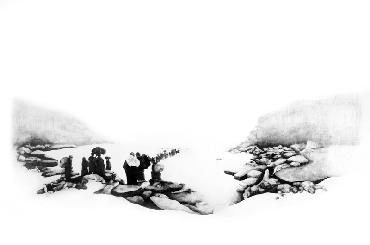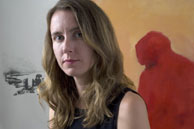MCAD/Jerome Artists 2005-06: Megan Vossler
Essays by Kristin Makholm, MCAD Gallery Director and Program Director, MCAD/Jerome Foundation Fellowships for Emerging Artists


Megan Vossler
War and its aftermath have often prompted artists to question why aggression and brutality are perpetuated. Artists such as Francisco Goya, Pablo Picasso and Otto Dix brandished their pens to envisage bullets and bombs and the revenge and retribution that follow. Since the 1850s, the camera has served as a primary eyewitness to war, its trace remnants still firmly imprinted on photographic negatives (or now, digital files). Photographs of the American Civil War, Hiroshima and Abu Ghraib can leave viewers shocked and spent, with little recourse to question or counter what they see.
With the advent of photojournalism—and, now, the World Wide Web, with its almost instantaneous access to images of all kinds—artists have faced the question of how they, too, can communicate the emotional complexities of war. Megan Vossler began her investigation by downloading news photographs of U.S. soldiers marching in Afghanistan, translating that sense of bated anticipation into pencil drawings of remarkable poignancy. Yet she quickly retreated from any direct image of the manifold conflicts in the Middle East and elsewhere in favor of what many of us have to go on: feelings of anger, sadness and helplessness in the shadow of global political, military and moral offensives.
To do this, Vossler set her critical eye on the heart-stopping dread of what occurs after bombs drop, when only death and hopelessness remain. In Aftermath, she creates a vast field of white—a sheet of paper, 5 feet by 6 feet in size—out of which corpses emerge and faceless columns of refugees march aimlessly by. Like her earlier drawings of soldiers weaving in and out of the blankness of white paper, the victims in Aftermath are simultaneously overwhelmed by and impregnated in the void. The contours of emptiness are as expressive as Vossler’s graphite marks, which vary in intensity between saturated silhouettes of massed figures and featherlight impressions of contorted faces. Shy of referring to any particular place or conflict, the drawing offers a timeless vision of war’s rupture, where bodies and rocks are barely distinguishable, both elements of the landscape of ruin.
Adding to the strength of these drawings is Vossler’s obvious homage to the powerful imagery that has influenced artists for generations. An art historian, Vossler has steeped herself in the historical language of combat and suffering, looking toward artists such as Michelangelo, Théodore Géricault and Goya for inspiration. Like a continuum that marches unabated—each new reference adding to the next—the legacies of these artists are channeled into Vossler’s work, imparting horrific scenes from Goya’s series The Disasters of War (1810–20), for example, into our contemporary consciousness. Each new account reminds us of the deep roots of human belligerence and the artist’s obligation to serve as an interpreter and ultimate witness. (K.M.)